Sedges
| Sedges | ||||||||||||
|---|---|---|---|---|---|---|---|---|---|---|---|---|

Slender sedge ( Carex acuta ) |
||||||||||||
| Systematics | ||||||||||||
|
||||||||||||
| Scientific name | ||||||||||||
| Carex | ||||||||||||
| L. |
Sedges ( Carex ) are a genus of plants from the sourgrass family (Cyperaceae). The over 2200 species thrive in the cold and climatically temperate areas almost worldwide.
description

Vegetative characteristics
Sedge species are perennial , herbaceous plants . A few species can bloom and fruit in the first year and then do not survive ( e.g. Carex bebbii , Carex viridula ). Some other species, such as Carex adusta , are short-lived; the plants do not live more than three to five years.
All species form rhizomes , but these are very short in clump-forming species. The rhizomes can also be designed as long stolons , so that the plants form extensive lawns. Some species such as Carex elata and other clump-forming species, as well as species in sand dunes, have rhizomes that grow vertically.
The stalks are mostly triangular, rarely stem-round. In most species, the only aerial shoot axes are the axes of the inflorescences. The leaves are basal on these or are arranged along the axis. Vegetative shoots usually have only basal leaves, their aerial part consists only of the overlapping leaf sheaths . Only a few species have vegetative shoots with a correct shoot axis with nodes and internodes . These are characteristic of the Ovales section , but also occur in the Holarrhenae and Carex sections . In some species, in addition to the normal, compressed sprouts, there are also those that develop into long stolons and thus serve for vegetative reproduction.
The leaves sit on the base and on the stalk, in some species all are basal. A ligule is present. The leaf blade is flat, V- or M-shaped in cross section. The blade is seldom thread, rolled up or rounded. Usually it is less than 20 millimeters wide. If it is flat, it has a clearly pronounced midrib. The leaf sheath is of diagnostic importance in the individual species: it is important here whether it tears open due to growth, tears into lobes or frayed like a network. The color of the leaf sheaths is also important.
Generative characteristics
The terminal inflorescences consist of spikelets that are in spikes , which in turn are grouped in spikes, grapes or panicles . The bracts of the ears are like leaves or scales. The bracts of the spikelets are scale-like and only very rarely foliage-like. The spikelets consist of a flower and have no or one scale. The flowers are unisexual: male flowers have no scales; female flowers have a scale with overgrown edges, which surrounds the flower as an utriculus (perigynium, false capsule) and is only open at the tip. There is no flower cover. The male flowers have one to three stamens . In the female flower, the styles are either sloping or remain on the fruit for different lengths of time. They are straight and lobed two to three times.
The fruits , they are achenes , are biconvex, plano-convex or triangular, rarely square.
The basic chromosome number is x = 10.
Locations
The representatives of the genus often occur in damp to wet locations. The water is rarely higher than 50 centimeters during the growing season. At such locations, sedges are often dominant or co-dominant. They also have a large share of the vegetation in the arctic tundra . Often they also occur in grasslands of the mountains, in rocky locations and in forests. In the forests of eastern North America, 20 or more species occur on a few hectares.
etymology
The generic name Carex is a Latin name for sour grasses with cutting leaves. The common name sedges is probably derived from a reconstructed Indo-European root * (s) ker- ( cut ).
Systematics and distribution
The genus Carex was established by Carl von Linné .
The genus Carex belongs to the tribe Cariceae in the subfamily Cyperoideae within the family Cyperaceae . Several studies have shown Carex to be a paraphyletic group in their classic scope . A newer classification that takes these results into account is still pending. In 2016, a phylogenetic study was published, in which 996 from 1983 about half of the known species were considered. Most of the previously recognized sections of the genus, which were set up on the basis of morphological features, were recognized as not monophyletic.
The genus Carex is distributed almost worldwide. It is only absent in the tropical lowlands, where it is only represented with a few species in Southeast Asia. The genus is also sparsely represented in sub-Saharan Africa. North America, on the other hand, is rich in species with around 480 species, and also East Asia.
The following species occur in Central Europe:
One-year sedges (Monostachyae)
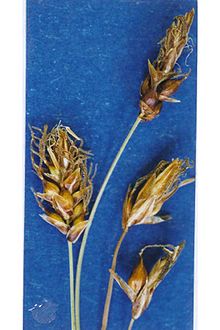

- Head sedge ( Carex capitata L. )
- Davall's sedge ( Carex davalliana Sm. )
- Dioecious sedge ( Carex dioica L. )
- Little awn sedge ( Carex microglochin Wahlenb. )
- Blunt sedge ( Carex obtusata Liljeblad )
- Arm-flowered sedge ( Carex pauciflora Lightf. )
- Flea Sedge ( Carex pulicaris L. )
- Rock sedge ( Carex rupestris all. )
Sedges of the same age (Homostachyae)


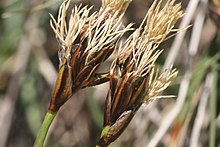

- Blackhead sedge ( Carex appropinquata Schumacher )
- Sand sedge ( Carex arenaria L. )
- Monte baldo sedge ( Carex baldensis L. )
- Sedge sedge ( Carex bohemica Schreber )
- Shivering grass sedge ( Carex brizoides L. )
- Brownish sedge ( Carex brunnescens (Pers.) Poir. )
- Gray sedge ( Carex canescens L. )
- Knitted Sedge ( Carex chordorrhiza L. f. )
- Curved sedge ( Carex curvula all. )
- Wire sedge ( Carex diandra cabinet )
- Tender sedge ( Carex disperma Dewey ): Subarctic and temperate zone of the northern hemisphere.
- Two-row sedge ( Carex disticha Hudson )
- Split sedge ( Carex divisa Hudson ): Europe to western China.
- Westphalian sedge ( Carex divulsa Stokes , Syn .: Carex guestphalica (Rchb.) Boenn. Ex O. Lang )
- Hedgehog sedge ( Carex echinata Murray )
- Long-legged sedge ( Carex elongata L. )
- Stink-Sedge ( Carex foetida All. ): The home is the Pyrenees and the Alps to the northwestern Balkan Peninsula.
- Peat sedge ( Carex heleonastes L. f. )
- Lachenals Sedge ( Carex lachenalii Schkuhr ): It occurs in one subspecies in the subarctic and temperate zone of the northern hemisphere and with the other subspecies in New Zealand.
- Harespaw sedge ( Carex leporina L. , Syn: Carex ovalis Good. )
- French sedge ( Carex ligerica J. Gay ): It occurs from Europe to Central Asia.
- Lole-like sedge ( Carex loliacea L. ): It occurs from Northern Europe and Central Europe to Japan and from Sub-Arctic America to Canada.
- Rush-leaved sedge ( Carex maritima Gunnerus )
- Bulky sedge ( Carex muricata L. )
- Grove sedge ( Carex otrubae podp. )
- Pairas sedge ( Carex pairae F.W. Schultz )
- Panicle sedge ( Carex paniculata L. )
- Early sedge ( Carex praecox Schreber )
- Reichenbach sedge ( Carex pseudobrizoides Clavaud ): It occurs from Western Europe to Latvia.
- Angle sedge ( Carex remota L. )
- Creeping sedge ( Carex repens Bellardi ): It occurs in Central Europe, Northern Italy and Romania.
- Prickly sedge ( Carex spicata Hudson )
- Fox sedge ( Carex vulpina L. )
- Multi- flowered sedge or fox-like sedge ( Carex vulpinoidea Michx. ): It is native to southern Canada to Mexico and Hispaniola .
Diverse sedges (Heterostachyae)


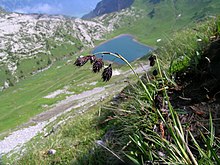


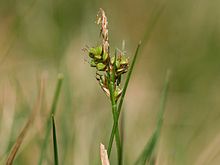
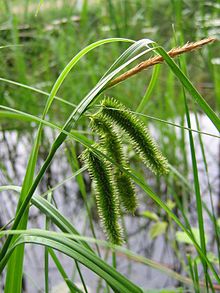


- Slender sedge ( Carex acuta L. )
- Marsh sedge ( Carex acutiformis Ehrh. )
- White sedge ( Carex alba Scop. )
- Water sedge ( Carex aquatilis Wahlenb. )
- Great awn sedge ( Carex atherodes Sprengel )
- Weeping sedge ( Carex atrata L. )
- Black and red sedge ( Carex atrofusca Schkuhr ): It occurs in two subspecies in the subarctic and temperate zone of the northern hemisphere.
- Southern Alpine sedge ( Carex austroalpina Bech. ): It occurs in the Pyrenees and in the Southern and Southwestern Alps.
- Two-colored sedge ( Carex bicolor All. ): It occurs from Europe to North Asia and from sub-Arctic America to Canada.
- Rigid sedge ( Carex bigelowii Torrey ex Schweinitz ): It occurs in four subspecies in the Himalayas and from subarctic America to the northern United States.
- Two-veined sedge ( Carex binervis Sm. )
- Short-term sedge ( Carex brachystachys closet )
- Banat sedge ( Carex buekii Wimmer )
- Buxbaum's sedge ( Carex buxbaumii Wahlenb. )
- Hairy sedge ( Carex capillaris L. )
- Spring sedge ( Carex caryophyllea Latourr. )
- Lawn Sedge ( Carex cespitosa L. )
- Greenish yellow sedge ( Carex demissa hornem. )
- Impoverished sedge or arm-flowered sedge ( Carex depauperata Curtis ex With. )
- Finger sedge ( Carex digitata L. )
- Distant sedge ( Carex distans L. )
- Stiff sedge ( Carex elata All. )
- Heath sedge ( Carex ericetorum pollich )
- Beach Sedge ( Carex extensa Good. )
- Rust sedge ( Carex ferruginea Scop. )
- Fringed sedge ( Carex fimbriata Schkuhr ): It occurs in the western Alps.
- Cushion sedge ( Carex firm host )
- Blue-green sedge ( Carex flacca Schreber )
- Yellow sedge ( Carex flava L. )
- Yellow sedges ( Carex flava agg .; collective species)
- Ice sedge ( Carex frigida all. )
- Fritsch sedge ( Carex fritschii Waisb. )
- Soot sedge ( Carex fuliginosa Schkuhr )
- Ball sedge ( Carex globularis L. ): It occurs from Northern Europe to Far Eastern Asiatic Russia.
- Haller's sedge ( Carex halleriana Asso )
- Hartman's sedge ( Carex hartmanii Cajander )
- Hairy sedge ( Carex hirta L. )
- Barley sedge ( Carex hordeistichos Vill. )
- Hem sedge ( Carex hostiana DC. )
- Earth sedge ( Carex humilis Leysser )
- Smooth sedge ( Carex laevigata Sm. )
- Thread sedge ( Carex lasiocarpa Ehrh. )
- Flaky yellow sedge ( Carex lepidocarpa Tausch )
- Mud sedge ( Carex limosa L. )
- Glossy sedge ( Carex liparocarpos Gaudin ): It occurs in two subspecies in northwest Africa and from Europe to Iran.
- Black-eared sedge ( Carex melanostachya Bieb. Ex Willd. )
- Micheli's sedge ( Carex michelii host ): It occurs from Europe to northwestern Iran.
- Mountain sedge ( Carex montana L. )
- Spiny Sedge ( Carex mucronata All. )
- Brown sedge ( Carex nigra (L.) Reichard )
- Norwegian sedge ( Carex norvegica Retz. ): It occurs in two subspecies from Europe to Russia's Far East, from Afghanistan to the Himalayas and from subarctic America to eastern Canada.
- Bird's foot sedge ( Carex ornithopoda Willd .; Incl. Carex ornithopodioides Hausm. )
- Chaffsed Sedge ( Carex paleacea Schreber ex Wahlenb. ): It occurs from central and eastern Canada to the northeastern United States and in northern and northeastern Europe.
- Pale sedge ( Carex pallescens L. )
- Millet sedge ( Carex panicea L. )
- Small-flowered sedge ( Carex parviflora host )
- Riesel Sedge ( Carex paupercula Michx. )
- Foot sedge ( Carex pediformis C.A.Meyer ): It occurs in four varieties from Eastern Europe to Korea.
- Hanging sedge ( Carex pendula hudson )
- Eyelash sedge ( Carex pilosa Scop. )
- Pill sedge ( Carex pilulifera L. )
- Pyrexia sedge ( Carex pseudocyperus L. )
- Spotted sedge ( Carex punctata Gaudin )
- Inn-Sedge ( Carex randalpina B.Walln. ): It occurs from the Alps to Hungary.
- Broad-leaved bladder sedge ( Carex rhynchophysa Fisch., CAMey. & Avé-Lall. ): It occurs from Europe to Japan and from North America to Mexico.
- Shore sedge ( Carex riparia curtis )
- Beaked sedge ( Carex rostrata stokes )
- Rye sedge ( Carex secalina Willd. Ex Wahlenb. )
- Horst sedge ( Carex sempervirens Vill. )
- Thin-eared sedge ( Carex strigosa Hudson )
- Low sedge ( Carex supina Willd. Ex Wahlenb. )
- Forest sedge ( Carex sylvatica Hudson )
- Felt sedge ( Carex tomentosa L. )
- Transylvanian sedge ( Carex transsilvanica Schur , Syn .: Carex depressa subsp. Transsilvanica (Schur) K. Richter ): It occurs in the Eastern Alps and from the Carpathians to Lithuania, on the Crimea and from Southeast Europe to Iran.
- Three-veined sedge ( Carex trinervis degl. )
- Shadow sedge ( Carex umbrosa host )
- Vaginal sedge ( Carex vaginata swap )
- Bladder sedge ( Carex vesicaria L. )
- Late yellow sedge ( Carex viridula Michx. )
More types
Further species of the genus Carex (without assignment, here is a selection):

- Gold sedge ( Carex aurea Nutt. ): It is widespread in North America from Alaska to Canada and in other areas of the USA.
- Berry Sedge ( Carex baccans Nees ), native to: tropical and subtropical Asia
- Carex bebbii Olney ex Britton , Home: Subarctic America, USA
- Carex berggrenii Petrie : New Zealand.
- Carex brunnea Thunb. , Home: subtropical Asia, northeastern tropical Africa, islands in the western Indian Ocean and from Australia to Lord Howe Island.
- Fuchsia sedge ( Carex buchananii Berggr. ), Home: New Zealand's North Island.
- Carex comans Berggr. , Home: New Zealand
- Carex conica Boott , home: Japan and South Korea.
- False hares foot sedge ( Carex crawfordii Fernald ), native to North America, naturalized in the Netherlands and the British Isles.
- Carex dipsacea Berggr. , Home: New Zealand.
- Carex flagellifera Colenso , native to New Zealand and Tasmania.
- Morning star sedge or gray sedge ( Carex grayi Carey ), native to Canada, USA.
- Carex hachijoensis Akiyama , Origin : Japan
- Carex kaloides Petrie , home: New Zealand (South Island)
- Carex kobomugi Ohwi : It occurs from Russia's Far East to temperate East Asia.
- Carex lemmonii W.Boott (Syn .: Carex albida L.H. Bailey ), home: California
- Carex macloviana d'Urv. , Home: Alaska, Canada, Northern Europe, Greenland, South America
- Carex macrocephala Willd. ex explos. , Home: Russia's Far East to Japan, Alaska to Oregon
- Japan sedge ( Carex morrowii Boott ), native to: Japan
- Palm frond sedge ( Carex muskungumensis Schwein. ), Origin : Canada, USA
- Oshima sedge ( Carex oshimensis Nakai ), origin : Japan
- Carex petriei Cheeseman , home: New Zealand
- Carex plantaginea Lam. , Home: Canada, USA
- Carex scaposa C.B. Clarke , native to: South China, Indochina
- Carex secta Boott , home: New Zealand
- Carex siderosticta Hance , home: Amur region, China, Manchuria, Korea, Japan
- Narrow-leaf sedge ( Carex stenophylla Wahlenb. ), Native to: Europe to Mongolia and the Himalayas.
- Carex tenuiculmis (Petrie) Heenan & PJ de Lange : It occurs on the South Island of New Zealand and on the Chatham Islands.
- Orange-colored New Zealand sedge ( Carex testacea Sol. Ex Boott ): It is only found in New Zealand.
- Carex trifida Cav. : It occurs in New Zealand, southern Chile and sub-Antarctic islands.
See also
literature
- PW Ball, AA Reznicek: Carex. In: Flora of North America Editorial Committee (Ed.): Flora of North America North of Mexico . Volume 23: Magnoliophyta: Commelinidae (in part): Cyperaceae . Oxford University Press, New York / Oxford a. a. 2002, ISBN 0-19-515207-7 , pp. 254-573 (English, online ). (Section Description and Distribution).
- W. Erhardt , E. Götz, N. Bödeker & S. Seybold: The great pikeperch. Encyclopedia of Plant Names. Volume 2. Types and varieties. Eugen Ulmer, Stuttgart (Hohenheim) 2008, ISBN 978-3-8001-5406-7 .
- Global Carex Group: Making Carex monophyletic (Cyperaceae, tribe Cariceae): a new broader circumscription. Bot J Linn Soc, 2015 , 179: 1-42. doi: 10.1111 / boj.12298
- AC Jermy, AO Chater, RW David: Sedges of the British Isles. Botanical Society of the British Isles, London 1982, ISBN 0-901158-05-4 .
- A. Petersen: The sour grasses. Keys to their destination in the flowerless state. Akademie-Verlag, Berlin 1973.
- JC Schou: De Danske Halvgraesser. Klitmöller (BFN's Forlag) 1993, ISBN 87-87746-04-2 .
- Wolfram Schultze Motel (Ed.): Illustrated flora of Central Europe. Pteridophyta, Spermatophyta . Founded by Gustav Hegi. 3rd, completely revised edition. Volume II. Part 1: Angiospermae: Monocotyledones 2 (Cyperaceae - Juncaceae) . Paul Parey, Berlin / Hamburg 1980, ISBN 3-489-54020-4 (published in deliveries 1967–1980).
Individual evidence
- ^ A b Manfred A. Fischer, Karl Oswald, Wolfgang Adler: Excursion flora for Austria, Liechtenstein and South Tyrol . 3rd, improved edition. Province of Upper Austria, Biology Center of the Upper Austrian State Museums, Linz 2008, ISBN 978-3-85474-187-9 , p. 1110 .
- ↑ Helmut Genaust: Etymological dictionary of botanical plant names. 3rd, completely revised and expanded edition. Birkhäuser, Basel / Boston / Berlin 1996, ISBN 3-7643-2390-6 , p. 128 limited preview in the Google book search.
- ^ PF AngiospermPhylogenyWebsite: Angiosperm Phylogeny Website , 200f. , accessed December 5, 2009.
- ↑ Pedro Jiménez-Mejías, Marlene Hahn, Kate Lueders, Julian R. Starr, Bethany H. Brown, Brianna N. Chouinard, Kyong-Sook Chung, Marcial Escudero, Bruce A. Ford, Kerry A. Ford, Sebastian Gebauer, Berit Gehrke , Matthias H. Hoffmann, Xiao-Feng Jin, Jongduk Jung, Sangtae Kim, Modesto Luceño, Enrique Maguilla, Santiago Martín-Bravo, Mónica Míguez, Ana Molina, Robert FC Naczi, Jocelyn E. Pender, Anton A. Reznicek, Tamara Villaverde , Marcia J. Waterway, Karen L. Wilson, Jong-Cheol Yang, Shuren Zhang, Andrew. L. Hipp, and Eric H. Roalson: Megaphylogenetic Specimen-Level Approaches to the Carex (Cyperaceae) Phylogeny Using ITS, ETS, and MatK Sequences: Implications for Classification. The Global Carex Group . Systematic Botany 41 (3) pp. 500-518. 2016 doi: 10.1600 / 036364416X692497
- ↑ a b c d e f g h i j k l m n o p q r s t u v w x y z aa ab ac ad ae af ag ah ai aj ak al am an ao ap aq ar as at au av aw ax ay Rafaël Govaerts (Ed.): Carex. In: World Checklist of Selected Plant Families (WCSP) - The Board of Trustees of the Royal Botanic Gardens, Kew . Retrieved August 18, 2018.




